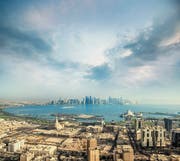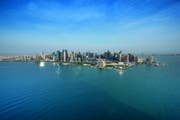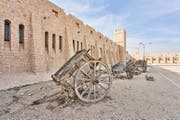The peninsular state of Qatar is, in some respects, a modern creation. However, the land itself shows evidence of habitation over millennia.
About Qatar
Qatar is welcoming 102 countries visa-free, check your visa status here.
About Qatar
The peninsular state of Qatar is, in some respects, a modern creation. However, the land itself shows evidence of habitation over millennia.
All tribes gather under the rule of the Al Thani family. This paves the way for stability, independence from neighbouring countries, and the forging of balanced relations with various entities in the region.
Sheikh Mohammed bin Thani signs an agreement with the British authorities in the Arabian Gulf, recognising Qatar as an independent political entity.
By the last quarter of the 19th century, Qatar is once again under Ottoman control. However, the country’s rulers maintain considerable independence along with an alliance with Britain. Under the rule of Sheikh Jassim bin Mohammed Al Thani, Qatar upholds its links with the Ottomans (despite differences in opinion over some issues) until Jassim's demise on 17th July, 1913 and the outbreak of World War I the following year.
Sheikh Abdullah bin Jassim Al Thani signs the 11-article Anglo-Qatari Treaty, while registering his reservations about three articles that he felt encroached on national sovereignty. These were:
Sheikh Abdullah renews the Anglo-Qatari Treaty and signs the first oil-prospecting agreement with the Anglo-Persian Oil Company. He also agrees to the appointment of a British Political Resident in Qatar (although this doesn’t actually take place until 1949, making Qatar the last Gulf country to agree to this measure).
Oil is first struck at the end of 1939, but exploration activities come to a halt during World War II. This coincides with a decline in the pearl-diving industry and a recession in the natural pearl market, adversely affecting Qatar's economy. The situation starts to improve by the early 1950s when the positive impact of oil exports is felt.
By acceding to the membership requirements of UN organisations such as UNESCO and the World Health Organisation (WHO), Qatar starts participating in international events. The country also takes part in the conferences of oil-producing countries.
The British government withdraws its troops from the East of Suez, ending the Arabian Gulf State protectorate era.
The first Qatari Constitution is ratified through an Interim Basic Statute that stipulates the formation of the first Council of Ministers.
Decree No. 35 is issued to enable the formation of a Cabinet, set the competencies of its ministers and determine the functions of other government agencies.
The Cabinet, comprising 10 ministerial portfolios, convenes for the first time.
On September 3, 1971, HH Sheikh Khalifa bin Hamad Al Thani, the then Heir Apparent and Prime Minister, declared the dissolution of the 1916 Treaty heralding a new phase in the country's history.
The first evidence of sustained human settlement in Qatar dates to the 6th millennium BCE, in the form of small, isolated farmsteads, stone tools and decorated pottery. These settlements belong to what is known as the ‘Ubaid period’, named after the site in southern Mesopotamia where this type of painted pottery was first discovered. This indicates that these early settlers had ties to the area that is now modern Iraq. During this period, the climate in eastern Arabia is believed to have been much wetter than it is now, with evidence of inland wells and the cultivation of wild cereal crops.
 The Pearl, Qatar
The Pearl, Qatar
 Doha skyline
Doha skyline
Although there are many Bronze Age sites across the Gulf, few remains from this era have been found in Qatar. The most important sites are concentrated in the Al Khor Region on the western coast of Qatar, as well as the Ras Brouq peninsula to the west.
The remains near Al Khor were concentrated on the island of Jazirat bin Ghannem (often referred to as Purple Island) near the coast, and included large quantities of murex (a small marine snail) shells used for producing purple dye. A Bronze Age campsite was excavated at Ras Brouq, where a few shards of Barbar Ware pottery (named after a site in Bahrain) were dated to the late 3rd millennium BCE. The largest concentration of Iron Age sites occurs on the west coast of Qatar, near the deserted police post at Umm al-Ma’a. The sites comprise more than 5,000 stone burial mounds dating between 300 BCE and 300 CE.
In spite of the large number of burials, some of which featured elaborate funeral objects, no related Iron Age settlements have been excavated nearby. Although there is historical evidence of Christianity in pre-Islamic Qatar (there was a bishop of Katara), there remains very little archaeological evidence of settlements from this period. At Al Wakrah, the remains of a large building constructed on bedrock was tentatively identified as a Nestorian church, while a rescue excavation in central Qatar recovered a large fragment of a Nestorian cross.
As early as 628 CE, Mundhir bin Sawa Al Tamimi, the Christian ruler of the Al Hasa region that included the Qatar peninsula, adopted Islam. Only a few sites have been identified from this early Islamic period, suggesting that the peninsula was sparsely populated at this time. During the Umayyad period, between the 7th and mid-8th centuries CE, Qatar became a centre for camel and horse breeding. The reign of the Abbasids (8th to 13th century CE) saw the growth of the pearl industry along the rich pearl banks in Qatar’s marine waters. Archaeological remains from the late Umayyad period were discovered at Yoghbi in northwestern Qatar, while remains from the early Abbasid period of the 9th and 10th centuries CE were discovered at nearby Murwab, comprising 250 houses, two mosques and a fortified mansion. In addition to Murwab, a number of other Abbasid-period sites have been identified in northern Qatar and are located inland.
Very little information is available on the history of the Gulf region between the 10th and 15th centuries CE, although the main centres of settlement appear to have been on the Iranian side of the Gulf. In Qatar, two archaeological sites from this period were located in Ruwayda and Freyha, on the north-west coast, and remained inhabited until the 18th century CE.
 Pearl diver
Pearl diver
In 1497, Portuguese explorer Vasco da Gama’s voyage to India via the Cape of Good Hope established a European maritime route to the East. This allowed Europeans to establish permanent trading bases in the Gulf region for the first time. During the 16th and the early 17th centuries, the territory comprising modern day Qatar was fought over by the Ottomans, Safavids and Portuguese. One of the earliest maps to include Qatar was a version of Ptolemy’s map (on display in Qatar National Library) depicting ‘Catara’ as a fort. Portuguese travellers referred to Qatar during the 1580s and 1590s, and there is a representation of Qatar as a single fort in Luis Lazaro’s World Atlas of 1596. The main references to Qatar can be found after 1602, when the Portuguese lost Bahrain to the Safavids. After this date, the Portuguese used Qatar as a base for raiding Bahrain as well as for taxing merchants travelling through the Gulf. Excavations in Ruwayda revealed a Portuguese fortification that may have been the same fort mentioned by Portuguese sources.
The earliest Ottoman reference to Qatar dates back to 1555, with Qatar considered part of the Ottoman province of Al Hasa, occupied in the 1550s. There was a great rivalry between the Portuguese and the Ottomans during the 16th century, particularly in relation to Bahrain, which the Portuguese occupied between 1521 and 1602. However, in the 1670s, the Sheikh of the Banu Khalid tribe expelled the Ottomans from Al Hasa, likely removing all Ottoman presence from Qatar.
 West Bay Skyline
West Bay Skyline
At this juncture, Qatar witnessed the rise of many tribal entities such as the Bani Khalid, who ruled a swathe of land that spanned Qatar and Kuwait. The Al-Musslam tribe was the predominant tribal group on the Qatar peninsula from at least the 16th century. Other tribes known to have lived in the region before the 18th century included the Al-Naim, or the Al-Hawala, a tribal confederation of sea-faring Arabs from the Iranian side of the Gulf. In the 18th century, Kuwait, Qatar and Bahrain were taken over by members of the ‘Utub tribal confederacy, which comprised a number of tribal groups including Al-Sabah, Al-Khalifa, Al-Fadhil and Al-Jalahimah. Although the majority of groups in the ‘Utub originated from central Arabia, at some point they became maritime, adopting boats as a primary means of transport.
A handful of 17th-century sites are known to have been occupied, even though the archaeological and historical evidence for their existence is fairly meagre. By the end of the 18th century, there was a wide network of settlements, particularly along the northern coast of the Qatar peninsula. One of the most significant changes in the 18th century was the virtual disappearance of the Portuguese population, and the arrival of merchants from the Netherlands, France and England. While these nations had been present in the Gulf during the 17th century, rivalry increased during the 1700s, resulting in a virtual British monopoly by the start of the 19th century. This laid the groundwork for Qatar’s modern history.
Things to do
Want to travel visa-free? Check if you qualify here.
Planning your trip to Qatar? Check how to get here.
Make the most of your visit with our handy travel guide.
From a dhow boat to our world-class metro, here’s how to easily explore Qatar.
